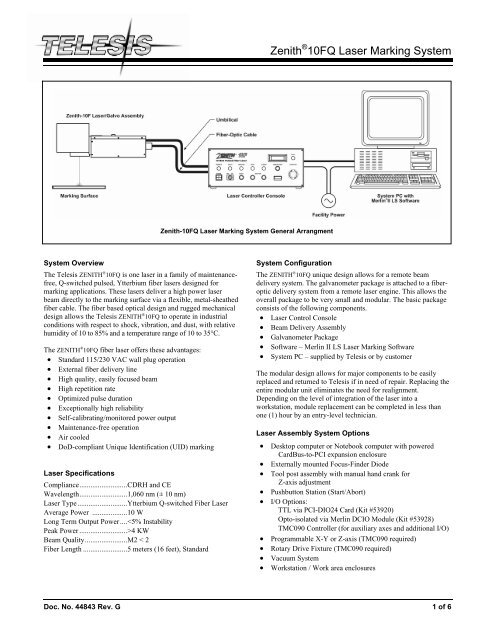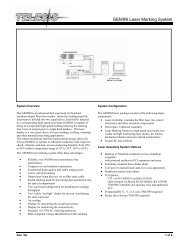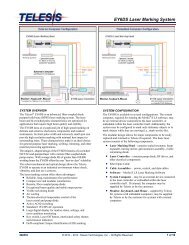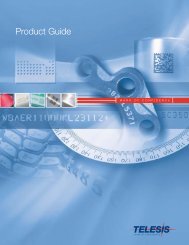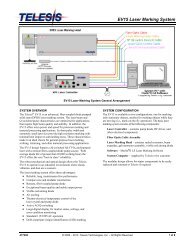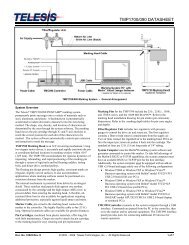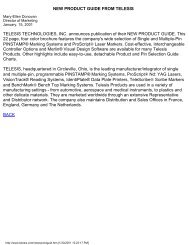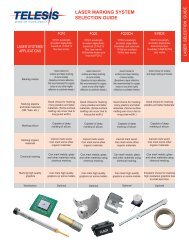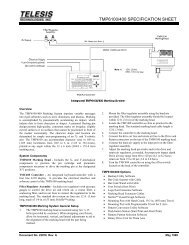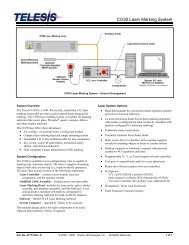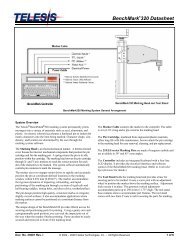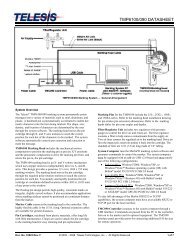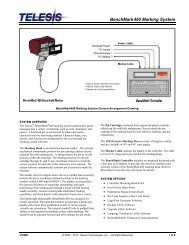Zenith 10FQ Laser Marking System - Telesis Technologies, Inc.
Zenith 10FQ Laser Marking System - Telesis Technologies, Inc.
Zenith 10FQ Laser Marking System - Telesis Technologies, Inc.
Create successful ePaper yourself
Turn your PDF publications into a flip-book with our unique Google optimized e-Paper software.
<strong>System</strong> Overview<br />
The <strong>Telesis</strong> ZENITH ® <strong>10FQ</strong> is one laser in a family of maintenancefree,<br />
Q-switched pulsed, Ytterbium fiber lasers designed for<br />
marking applications. These lasers deliver a high power laser<br />
beam directly to the marking surface via a flexible, metal-sheathed<br />
fiber cable. The fiber based optical design and rugged mechanical<br />
design allows the <strong>Telesis</strong> ZENITH ® <strong>10FQ</strong> to operate in industrial<br />
conditions with respect to shock, vibration, and dust, with relative<br />
humidity of 10 to 85% and a temperature range of 10 to 35°C.<br />
The ZENITH ® <strong>10FQ</strong> fiber laser offers these advantages:<br />
• Standard 115/230 VAC wall plug operation<br />
• External fiber delivery line<br />
• High quality, easily focused beam<br />
• High repetition rate<br />
• Optimized pulse duration<br />
• Exceptionally high reliability<br />
• Self-calibrating/monitored power<br />
output<br />
• Maintenance-free<br />
operation<br />
• Air cooled<br />
• DoD-compliant Unique Identification (UID) marking<br />
<strong>Laser</strong> Specifications<br />
Compliance..........................CDRH and CE<br />
Wavelength..........................1,060 nm (± 10 nm)<br />
<strong>Laser</strong> Type...........................Ytterbium<br />
Q-switched Fiber <strong>Laser</strong><br />
Average Power ...................10 W<br />
Long Term Output Power....4 KW<br />
Beam Quality.......................M2 < 2<br />
Fiber Length ........................5 meters (16 feet), Standard<br />
<strong>Zenith</strong>-<strong>10FQ</strong> <strong>Laser</strong> <strong>Marking</strong> <strong>System</strong> General Arrangment<br />
<strong>Zenith</strong> ® <strong>10FQ</strong> <strong>Laser</strong> <strong>Marking</strong> <strong>System</strong><br />
<strong>System</strong> Configuration<br />
The ZENITH ® <strong>10FQ</strong> unique design allows for a remote beam<br />
delivery system. The galvanometer package is attached to a fiberoptic<br />
delivery system from a remote laser engine. This allows the<br />
overall package to be very small and modular. The basic package<br />
consists of the following components.<br />
• <strong>Laser</strong> Control Console<br />
• Beam Delivery Assembly<br />
• Galvanometer Package<br />
• Software – Merlin II LS <strong>Laser</strong> <strong>Marking</strong> Software<br />
• <strong>System</strong> PC – supplied by <strong>Telesis</strong> or by customer<br />
The modular design allows for major components to be easily<br />
replaced and returned to <strong>Telesis</strong> if in need of repair. Replacing the<br />
entire modular unit eliminates the need for realignment.<br />
Depending on the level of integration of the laser into a<br />
workstation, module replacement can be completed in less than<br />
one (1) hour by an entry-level technician.<br />
<strong>Laser</strong> Assembly <strong>System</strong> Options<br />
• Desktop computer or Notebook computer with powered<br />
CardBus-to-PCI expansion enclosure<br />
• Externally mounted Focus-Finder Diode<br />
• Tool post assembly with<br />
manual hand crank for<br />
Z-axis adjustment<br />
• Pushbutton Station<br />
(Start/Abort)<br />
• I/ O Options:<br />
TTL via PCI-DIO24 Card (Kit #53920)<br />
Opto-isolated via Merlin DCIO Module (Kit #53928)<br />
TMC090 Controller (for auxiliary axes and additional<br />
I/O)<br />
• Programmable X-Y or Z-axis (TMC090 required)<br />
• Rotary Drive Fixture<br />
(TMC090 required)<br />
• Vacuum <strong>System</strong><br />
• Workstation / Work area enclosures<br />
Doc. No. 44843 Rev. G 1 of 6
<strong>Laser</strong> Control Console<br />
The laser source is located in the control console enclosure.<br />
Designed to meet CDRH and CE standards, the control console<br />
enclosure also contains the galvo power supplies, driver control<br />
circuits, fusing, and the selectable 115/230 VAC, 50 Hz/60 Hz<br />
power jack. This unit includes the system key switch and laser off<br />
switch, a manual safety shutter control, function indicators, and<br />
digital displays. The enclosure is designed to fit in a standard 19-in.<br />
rack (48.3 x 20 x 60 cm) or it can be placed directly on a desktop.<br />
ZENITH ® <strong>10FQ</strong> <strong>Laser</strong> Controller Console<br />
The solid-state laser source within the control enclosure does not<br />
contain the traditional laser crystal, front and rear mirrors and light<br />
amplifier arrangement known as the laser resonator.<br />
<strong>Zenith</strong>-<strong>10FQ</strong> Dimensions and Mounting Details<br />
<strong>Zenith</strong> ® <strong>10FQ</strong> <strong>Laser</strong> <strong>Marking</strong> <strong>System</strong><br />
Sometimes simply called the laser engine, this is a true solid state<br />
Ytterbium fiber light amplifier. The Ytterbium fiber laser design<br />
offers a modern and unique concept for laser beam generation; the<br />
optical fiber itself is the lasing medium. With no laser crystal or<br />
intra-resonator optics, the entire laser assembly is reduced to a<br />
compact, lightweight, easily replaceable sealed package.<br />
Co-focal through the lens, red light diodes are available with<br />
Ytterbium fiber laser markers functioning primarily as a laser<br />
positioning / dry run feature.<br />
<strong>Laser</strong> Controller Specifications<br />
Dimensions (W x H x L) .......standard 19 in. rack mount:<br />
43.2 x 19.1 x 59.7 cm<br />
17.0 x 7.5 x 23.5 in.<br />
Weight...................................24 Kg (53 lbs.)<br />
Input Power (selectable)........115/230 VAC 50/60 Hz<br />
Cooling..................................Air cooled, fan/filter<br />
Avg. Power Consumption .....350 Watts<br />
Operating Range....................10° to 35°C (50° to 95°F)<br />
Humidity ...............................10% to 85% non-condensing<br />
Expected MTBF (diode)........Greater than 50,000 hours<br />
maintenance-free<br />
Power Monitoring..................LED display<br />
Optical Isolator......................Optional<br />
Positioning.............................Visible Red Diode Light<br />
Doc. No. 44843 Rev. G 2 of 6
Fiber Optic Beam Delivery Assembly<br />
The beam is delivered from the laser source (in the laser control<br />
console) through a fiber optic cable to the galvo assembly. One<br />
end of the fiber optic cable is a permanently attached directly to<br />
the laser light source and cannot be removed. The standard cable<br />
for the ZENITH ® <strong>10FQ</strong> is 5 meters (16 feet) long.<br />
The output end of the fiber optic cable, which attaches to the galvo<br />
mounting block assembly, is fitted with a specially designed<br />
optical beam expander which is factory sealed into a machined<br />
steel housing. This is a very flexible, stainless steel armored,<br />
plastic sheathed, optically pure fiber cable designed for industrial<br />
applications. When properly mounted, this machined steel housing<br />
aligns the beam to the galvo assembly. The machined steel<br />
housing cannot be removed from the fiber cable without special<br />
tools and should not be attempted in the field without first<br />
contacting <strong>Telesis</strong> Service. Improper removal may expose optical<br />
lenses to outside contamination or, in extreme cases, expose<br />
personnel to active laser energy. Under no circumstances should<br />
the fiber optic cable be disconnected from the beam delivery<br />
assembly without taking proper safety precautions.<br />
Galvanometer Package<br />
Beam Delivery<br />
The Galvanometer package consists of a galvo mounting block<br />
and electro-mechanical safety shutter. The galvo block is a<br />
machined aluminum component that allows for precision<br />
mounting and alignment of both the beam delivery assembly and<br />
the galvanometer beam steering assembly. The barrel of the beam<br />
delivery extends into the block and to a shoulder, creating the<br />
proper standoff from the first galvo mirror.<br />
<strong>Zenith</strong> ® <strong>10FQ</strong> <strong>Laser</strong> <strong>Marking</strong> <strong>System</strong><br />
Between the sealed fiber coupler and the beam expander assembly<br />
is a safety shutter. Under power, a precision-drilled hole in the<br />
rotating drum is aligned with the beam path, allowing laser energy<br />
to pass through to the first galvanometer steering mirror. If the<br />
shutter is closed, or power is removed from the system (e.g., an<br />
emergency stop condition) the spring-loaded barrel will rotate to<br />
inhibit the beam.<br />
The size of the ZENITH ® <strong>10FQ</strong> fiber-to-fiber laser allows<br />
positioning of the laser galvo assembly in almost any angle. This<br />
provides an almost unlimited angle of attack for marking directly<br />
upon even the most difficult part configurations.<br />
Galvanometer (<strong>Marking</strong> Head) Specifications<br />
Dimensions (W x H x L) ...............12.7 x 17.25 x 45.44 cm<br />
5.0 x 6.79 x 17.89 in.<br />
Weight...........................................5.45 Kg (12 lbs.)<br />
Galvanometer Optical Scanners<br />
Each galvo assembly has two optic scanning galvanometers, one<br />
each for controlling X-axis beam positioning and Y-axis beam<br />
positioning. Galvanometer scanners are computer-controlled highperformance<br />
precision closed-loop rotary motors. They consist of<br />
a motor section based on moving magnet technology and a highprecision<br />
closed-loop position detector. Attached to each motor<br />
shaft is an optically coated mirror assembly to deflect the beam.<br />
Each optically coated mirror assembly is factory balanced and<br />
bonded, then each combination of mirror and motor assembly are<br />
electronically equalized in the control circuitry.<br />
Galvanometer Optical Scanners<br />
Doc. No. 44843 Rev. G 3 of 6
Flat Field Lens, Final Objective Lens, (F-Theta Lens)<br />
The final object lens is key to the marking performance of the<br />
system. This is the final coated optical lens that the beam will<br />
pass through before it strikes the marking target. The final<br />
objective lens is sometimes called the F-Theta lens because the<br />
lens is optically corrected to provide an image height that is<br />
proportional to the scan angle (Theta), not the tangent of that<br />
angle, as is usually the case with traditional optical lenses. This<br />
lens is also called a flat field lens because when the beam is<br />
focused, the focus lies in a plane perpendicular to the optical<br />
axis of the lens. To protect the final objective lens from dust<br />
and debris, a clear protective cover is inserted between the<br />
work area and the lens. The lens and protective cover is held in<br />
place by a threaded adapter ring called a bezel (mounting kit).<br />
The bezel threads directly into the machined galvo block. The<br />
lens and protective cover can be replaced in less than five (5)<br />
minutes. A properly maintained lens will remain functional<br />
indefinitely. Periodically, as a standard practice, the lens<br />
should be cleaned using an approved optical lens cleaner and<br />
soft optical tissue.<br />
The following chart outlines the available lenses, their part<br />
numbers, the mounting kit (bezel) part numbers, and the resulting<br />
image field provided by the lens (in millimeters and inches).<br />
Lens<br />
Lens<br />
Part No.<br />
Mount. Kit<br />
Part No.<br />
Typical Image<br />
Field (mm)<br />
Typical Image<br />
Field (in)<br />
100 mm 42553 46846 45 x 45 1.77 x 1.77<br />
160 mm 29942 46847 90 x 90 3.54 x 3.54<br />
163 mm 42554 46848 110 x 110 4.33 x 4.33<br />
254 mm 42555 46849 155 x 155 6.10 x 6.10<br />
<strong>Marking</strong> Characteristics<br />
Spot Size (line width). The laser spot size can be thought of as<br />
the line width of the image being marked. For all practical<br />
purposes, the laser-created text (or any machine-readable code)<br />
can be programmed to mark or engrave smaller than can be seen<br />
without magnification. In the opposite extreme, it can be marked so<br />
large as to cover the entire marking field.<br />
In all cases, laser spot size is dependent on a variety of factors<br />
including lens selection, focus, and the material being marked.<br />
The following chart is provided for reference only.<br />
Lens Spot Size (line width)<br />
100 mm 25 microns (.0010 in.)<br />
160 mm 40 microns (.0015 in.)<br />
163 mm 40 microns (.0015 in.)<br />
254 mm 60 microns (.0025 in.)<br />
<strong>Zenith</strong> ® <strong>10FQ</strong> <strong>Laser</strong> <strong>Marking</strong> <strong>System</strong><br />
<strong>Marking</strong> Field Size. The size of the marking field is dependent<br />
on lens type.<br />
Doc. No. 44843 Rev. G 4 of 6<br />
Lens<br />
<strong>Marking</strong> Field<br />
(mm) (in.)<br />
Working<br />
Clearance<br />
(mm) (in.)<br />
100 mm 45 x 45 1.77 x 1.77 97 3.82<br />
160 mm 90 x 90 3.54 x 3.54 176 6.93<br />
163 mm 110 x 110 4.33 x 4.33 185 7.28<br />
254 mm 155 x 155 6.10 x 6.10 296 11.65<br />
<strong>System</strong> PC<br />
The laser system requires an IBM-compatible computer for<br />
running the Merlin ® II LS <strong>Laser</strong> <strong>Marking</strong> Software. The PC may<br />
be a desktop or a notebook computer and may be supplied by<br />
<strong>Telesis</strong> or by the customer. If the PC is supplied by <strong>Telesis</strong>,<br />
warranty for the computer, computer keyboard, monitor, and<br />
peripherals default to the original equipment manufacturer.<br />
Galvo control cards are included, along with interconnect cabling.<br />
The laser software is installed and the entire unit is tested as a<br />
laser marking system.<br />
The minimum computer requirements are as follows:<br />
• Windows ® 2000 or Windows ® XP<br />
• <strong>Telesis</strong> Merlin ® II LS <strong>Laser</strong> <strong>Marking</strong> Software<br />
• Pentium ® III, 128 MB RAM (minimum)<br />
• Multi-gigabyte, HDD<br />
• CD-ROM and 3.5 in. External Disk Drives<br />
• SVGA Color Monitor, Mouse, and Keyboard<br />
• <strong>Laser</strong>/Galvo Controller<br />
Board<br />
• Video Card<br />
• One available RS-232 Serial Port<br />
• Two available USB Ports<br />
• Two (minimum) full-height PCI Slots *<br />
Note: If a notebook computer is used, expansion<br />
must be used to provide the PCI slots.
Communications Protocol<br />
Two types of host interface are supported (RS-232 or TCP/IP) and<br />
two communication protocols are provided through the Merlin-II LS<br />
marking system software (Programmable and Extended).<br />
Programmable Protocol. This protocol is used where very simple<br />
one-way communications are required (such as with bar code<br />
scanners). Programmable Protocol provides no error checking or<br />
acknowledgment of transmitted data. Note that XON/XOFF<br />
Protocol applies even when Programmable Protocol is selected.<br />
Extended Protocol. This protocol includes error checking and<br />
transmission acknowledgment. It should be used in applications<br />
where serial communication is a vital part of the marking<br />
operation.<br />
Remote Communications<br />
The communication capability of the marking system software<br />
allows you to control the laser from remote I/O devices. Remote<br />
communications can be performed by connecting to a Host<br />
computer, an optional I/O card, or an optional TMC090 Auxiliary<br />
Controller.<br />
Host Communications. Remote communications may be<br />
executed from a host computer using RS-232 or Ethernet (TCP/IP)<br />
connections to the system computer (i.e., the PC running the<br />
<strong>Telesis</strong> laser marking software). The software provides parameters<br />
to define the data transmitted to and from the host. For more<br />
information on using and configuring these parameters, refer to<br />
the Operation Manual supplied with the laser marking software.<br />
I/O Card. <strong>Telesis</strong> offers an optional I/O card that provides six<br />
input signals (Start Print, Abort, and four programmable inputs)<br />
and six output signals (Ready, Done, Paused, and three<br />
programmable outputs). The I/O card is available in kit #53928.<br />
For more information on using the optional I/O card, refer to the<br />
<strong>Telesis</strong> Optional I/O Card Installation Supplement supplied in<br />
each of these kits.<br />
TMC090 Controller. <strong>Telesis</strong> offers an optional TMC090<br />
Controller for all laser systems that use the Merlin-II LS <strong>Laser</strong><br />
<strong>Marking</strong> Software. The TMC090 Controller provides an interface<br />
for connecting six input and six output signals to and from the<br />
laser marking system, and for connecting the optional auxiliary<br />
axes: vertical (Z) axis, rotational (Theta) axis, and linear (L1 and<br />
L2) axes. For details, refer to the TMC090 Installation/<br />
Maintenance Manual supplied with the controller.<br />
<strong>Zenith</strong> ® <strong>10FQ</strong> <strong>Laser</strong> <strong>Marking</strong> <strong>System</strong><br />
<strong>System</strong> Software<br />
<strong>Telesis</strong>’ powerful WIN32 Merlin ® II LS <strong>Laser</strong> <strong>Marking</strong> Software is<br />
a PC-based operating software package that comes standard with<br />
the laser marking system. It is a graphical user interface that<br />
makes marking pattern design quick and easy. The WYSIWYG<br />
(what-you-see-is-what-you-get) interface provides a to-scale<br />
image of the pattern as it is created. Just “click and drag” for<br />
immediate adjustment to field size, location, or orientation.<br />
The Merlin ® II LS includes tools to create and edit text (at any<br />
angle), arc text, rectangles, circles, ellipses, and lines. Multiple<br />
fields may be grouped and saved as a block to form a logo.<br />
Existing DXF CAD files can also be imported for marking. Nonprintable<br />
fields can be created to clearly display a graphical<br />
representation of the part being marked.<br />
Overview of Merlin-II LS User Interface<br />
Merlin ® II LS <strong>Laser</strong> <strong>Marking</strong> Software Specifications<br />
Operating <strong>System</strong> ..................Windows ® 2000 or Windows ® XP<br />
Desktop PC or Notebook PC<br />
Font Generation.....................True Type Fonts<br />
Barcodes and Matrix .............2D Data Matrix, PDF417, BC 39,<br />
Interleaved 2 of 5, UPCA/UPCE BC<br />
128, Maxi Code, Code 93, QR Code<br />
and others<br />
Graphic Formats....................Raster and Vector: BMP, GIF, JPG,<br />
WMF, EMF, PLT, DXF<br />
Serialization...........................Automatic and Manual Input<br />
Host Interface Capable<br />
Linear <strong>Marking</strong>......................Scalable with Letter Spacing<br />
Control<br />
Arc Text <strong>Marking</strong>..................Scalable and Adjustable<br />
Drawing Tools.......................Line, Rectangle, Circle, Ellipse<br />
Doc. No. 44843 Rev. G 5 of 6
<strong>System</strong> Setup<br />
Complete installation procedures are provided in the <strong>Zenith</strong>-<strong>10FQ</strong><br />
Installation/Maintenance Manual. The following procedures are<br />
listed for reference only to provide a general overview of the<br />
installation process.<br />
1. Equipment should remain powered down and in the OFF<br />
position until the mounting is complete.<br />
2. Place the computer, monitor keyboard and laser control<br />
console in the desired location. Locate the controller as<br />
close as practical to the marking head. The standard cable<br />
length is 5 meters (16 feet).<br />
3. Locate the galvo mounting block assembly to the mounting<br />
position taking care not to bend or kink the fiber optic cable.<br />
The fiber optic cable will take an approximately 305 mm<br />
(12 in.) diameter bend without damage.<br />
4. Mount the laser galvo mounting block assembly by using<br />
four M6-1.0 bolts. Mounting bolts must not extend into<br />
the galvo block as to interfere with the internal<br />
components.<br />
a. Mounting holes are tapped for metric threads. The<br />
mounting pattern for the ZENITH ® <strong>10FQ</strong> laser is a four<br />
(4) hole rectangular pattern 2.0 in. wide by 3.75 in.<br />
long (50.8 x 95.25 mm). The holes are tapped 3/8 in.<br />
deep for M6-1.00 bolts. Standard clearance holes<br />
(0.26 in.) for M6-1.00 bolts should be used for this<br />
pattern.<br />
b. The leading edge of the mounting plate should be no<br />
greater than .875 in. (22.23 mm) from the first set of<br />
holes to allow clearance for the beam output lens.<br />
c. As viewed from the front of the laser in the upright<br />
position, the center of the output beam is 3.125 in.<br />
(79.38 mm) forward of the first set of mounting holes<br />
and 0.754 in. (19.15 mm) inward from the right side<br />
set of mounting holes.<br />
d. A minimum distance of 6.0 in. (152.4 mm) should be<br />
allowed from the rear of the laser to allow for proper<br />
bend radius of the fiber optic cable<br />
5. Ensure the laser control console power switch (on front<br />
panel) is OFF.<br />
6. Select the proper voltage setting (either 115V or 230V), then<br />
connect the power cable.<br />
7. Connect the remaining cables.<br />
8. Refer to the <strong>Zenith</strong>-<strong>10FQ</strong> Operation Supplement for proper<br />
startup procedure of the complete system.<br />
9. Refer to the laser marking system Operation Manual for<br />
complete information on using the system software.<br />
<strong>Zenith</strong> ® <strong>10FQ</strong> <strong>Laser</strong> <strong>Marking</strong> <strong>System</strong><br />
General Mounting Procedures<br />
If you chose to integrate the laser into a workstation that has not<br />
been designed by <strong>Telesis</strong>, you should keep in mind the following<br />
engineering considerations when integrating your system.<br />
• Design simple X-, Y-, and Z-axis adjustments.<br />
When designing a mounting fixture for the laser marking<br />
head, allow for simple three-axis adjustment to aid in<br />
horizontal, vertical, and lateral alignment of the laser marking<br />
head. Experience has shown that a minimum adjustment<br />
value of 12.7 mm (0.50 in.) is a prudent design consideration<br />
if the intent is to integrate the laser into workstation not<br />
designed by <strong>Telesis</strong>.<br />
• Ensure the part and the part holding fixture are<br />
perpendicular to the final objective lens.<br />
When designing a work piece holding fixture, ensure the<br />
fixture is flat relative to the final objective lens of the galvo<br />
block assembly and square to the centerline of the laser<br />
marking field.<br />
• Ensure the part is stable and will not move during<br />
marking.<br />
<strong>Laser</strong> marking is a non-contact marking method. Typically all<br />
that is needed is simple fixturing pockets or X-axis, Y-axis<br />
datum rails.<br />
• Ensure the part width and length will fit in the marking<br />
area.<br />
Double check that all the parts to be marked will fit within<br />
the laser marking field. Ensure the marking area is not<br />
obstructed and can be targeted by the laser beam .<br />
• Ensure the combined total height of the part and<br />
fixturing does not exceed the working clearance of the<br />
final objective lens selected.<br />
Care should be taken to ensure that the laser can be placed<br />
into focus on the part. The total combination of the part and<br />
fixturing height must not exceed the adjustment capability of<br />
the customer-supplied Z-axis. The working clearance is the<br />
distance between the bottom of the lens and the top of the<br />
part to be marked. See <strong>Marking</strong> Characteristics (<strong>Marking</strong><br />
Field Size) for details on working clearances for the available<br />
lenses.<br />
Doc. No. 44843 Rev. G 6 of 6


